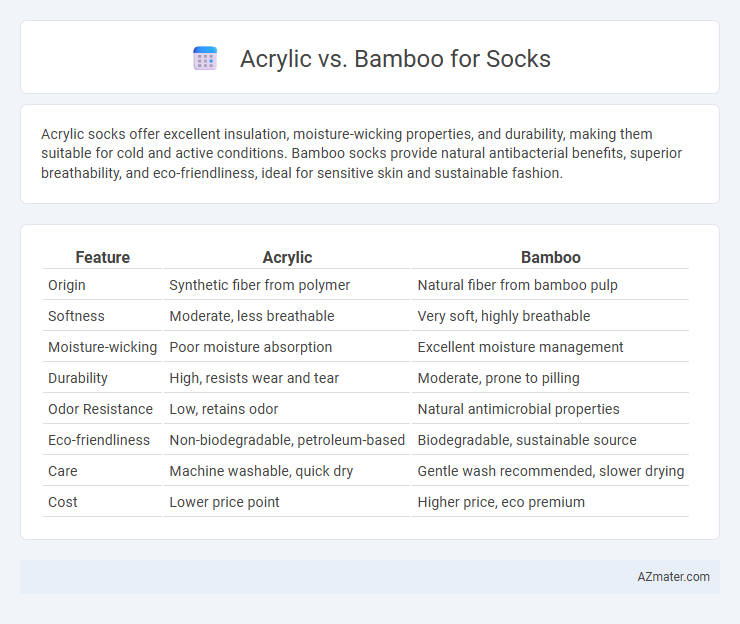Acrylic socks offer excellent insulation, moisture-wicking properties, and durability, making them suitable for cold and active conditions. Bamboo socks provide natural antibacterial benefits, superior breathability, and eco-friendliness, ideal for sensitive skin and sustainable fashion.
Table of Comparison
| Feature | Acrylic | Bamboo |
|---|---|---|
| Origin | Synthetic fiber from polymer | Natural fiber from bamboo pulp |
| Softness | Moderate, less breathable | Very soft, highly breathable |
| Moisture-wicking | Poor moisture absorption | Excellent moisture management |
| Durability | High, resists wear and tear | Moderate, prone to pilling |
| Odor Resistance | Low, retains odor | Natural antimicrobial properties |
| Eco-friendliness | Non-biodegradable, petroleum-based | Biodegradable, sustainable source |
| Care | Machine washable, quick dry | Gentle wash recommended, slower drying |
| Cost | Lower price point | Higher price, eco premium |
Overview: Comparing Acrylic and Bamboo for Socks
Acrylic socks offer durability, vibrant color retention, and excellent moisture-wicking properties, making them ideal for active wear and cold weather. Bamboo socks provide natural antibacterial benefits, superior softness, and eco-friendly sustainability, ensuring comfort and odor resistance for sensitive skin. Choosing between acrylic and bamboo depends on prioritizing performance and longevity versus eco-conscious comfort and breathability.
Material Composition: What Are Acrylic and Bamboo?
Acrylic is a synthetic fiber made from polyacrylonitrile polymer, known for its durability, moisture-wicking, and soft texture that mimics wool, making it popular in sock manufacturing. Bamboo fibers come from the cellulose of bamboo plants, offering natural antibacterial properties, breathability, and eco-friendliness, appealing to consumers seeking sustainable sock materials. Understanding the material composition highlights acrylic's synthetic nature versus bamboo's plant-based origin, influencing sock performance, comfort, and environmental impact.
Comfort and Softness: How Do They Feel?
Bamboo socks offer superior softness and breathability due to their natural fibers, making them gentle and comfortable for sensitive skin. Acrylic socks, while durable and moisture-wicking, tend to feel less soft and can sometimes cause irritation with prolonged wear. The natural hypoallergenic properties and temperature regulation of bamboo enhance overall comfort compared to the synthetic texture of acrylic.
Breathability and Moisture-Wicking
Bamboo socks outperform acrylic in breathability due to their natural fiber structure, allowing better air circulation and keeping feet cooler. Moisture-wicking properties in bamboo fibers absorb and evaporate sweat more efficiently than acrylic, reducing odor and discomfort. Acrylic, as a synthetic fiber, tends to trap heat and moisture, making it less ideal for active wear or warm conditions.
Durability and Longevity
Bamboo socks offer superior durability due to their natural fiber strength and moisture-wicking properties, which reduce wear caused by sweat and friction. Acrylic socks, while affordable and soft, tend to wear out faster because the synthetic fibers break down more quickly under repeated use and washing. Long-lasting performance is typically achieved with bamboo socks, making them a better choice for sustained durability in everyday wear.
Warmth and Insulation Properties
Acrylic socks provide excellent warmth and insulation due to their synthetic fibers, which trap heat effectively and wick moisture away from the skin, making them ideal for cold and damp conditions. Bamboo socks offer natural temperature regulation with moderate insulation, featuring breathable fibers that keep feet cool when warm and warm when cool, but generally provide less heat retention than acrylic. For maximum warmth and insulation, acrylic fibers outperform bamboo, especially in extreme cold environments.
Sustainability and Environmental Impact
Bamboo fibers are highly sustainable due to rapid growth rates, minimal water usage, and natural antimicrobial properties, reducing the need for chemical treatments in sock production. Acrylic, a synthetic fiber derived from petrochemicals, requires significant energy for manufacturing and decomposes slowly, contributing to microplastic pollution. Choosing bamboo socks supports eco-friendliness through renewable sourcing and biodegradability, whereas acrylic socks pose long-term environmental challenges.
Allergenicity and Skin Sensitivity
Acrylic socks may cause irritation for sensitive skin due to synthetic fibers that trap moisture and heat, increasing the risk of allergic reactions. Bamboo socks are naturally hypoallergenic and possess moisture-wicking properties, reducing skin irritation and promoting breathability. Choosing bamboo socks helps minimize allergen exposure and supports skin health for individuals prone to sensitivities.
Maintenance and Care Tips
Acrylic socks offer low-maintenance benefits with easy machine washing and quick drying, resisting wrinkles and shrinking. Bamboo socks require gentler care, recommending cold water washes and air drying to preserve their softness and antibacterial properties. Proper maintenance extends the lifespan of both materials while ensuring comfort and durability.
Choosing the Right Material for Your Socks
Choosing between acrylic and bamboo for socks depends on desired comfort and durability; acrylic offers excellent moisture-wicking and is budget-friendly, while bamboo provides natural antibacterial properties and superior softness ideal for sensitive skin. Bamboo fibers are breathable and eco-friendly, making them suitable for environmentally conscious consumers seeking sustainability alongside comfort. Acrylic socks, however, excel in maintaining shape and resisting wear, making them a practical choice for heavy use or athletic activities.

Infographic: Acrylic vs Bamboo for Sock
 azmater.com
azmater.com